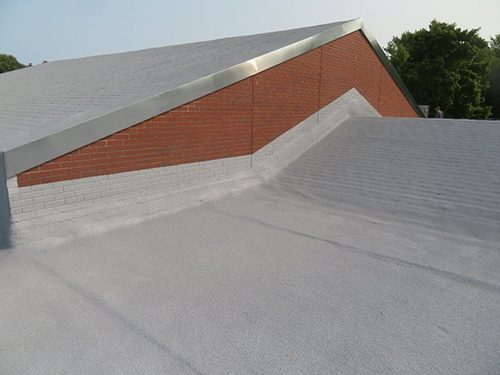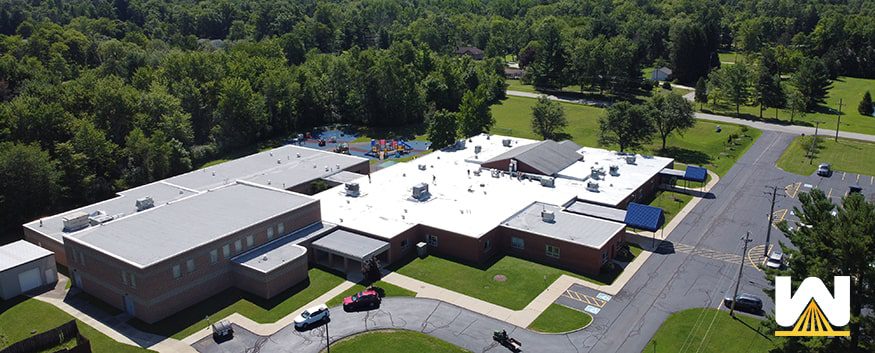Summary: Sometimes commercial roofing projects can be very complex. Different roof systems, multiple penetrations, different slopes…these can all happen in one roofing project. These difficulties make projects expensive, as was the case for Metzenbaum Center in Geauga County until they installed a non-traditional roofing system.
Let’s say that you’re the property manager of a large commercial building. The roof has been leaking, repairs have been made, but the repairs are too frequent.
It’s time to start collecting bids for a new roof.
You bring contractor after contractor onto your roof and they give you a proposal.
Let’s say your maximum budget for a new roof is $250,000.
- Bid #1 comes in…$285,000.
- Bid #2 comes in…$275,000.
- Bid #3 comes in…$280,000.
And you wonder, why hasn’t anyone given me a quote under my budget?
Today we wanted to talk about why some roofing projects are so expensive to complete. This might explain why no one has proposed a solution under budget.
At the end, we’ll talk about a lesser-known roofing system, spray polyurethane foam roofing, and the advantages that allow it to sometimes come in under budget on roofing projects.
Let’s begin.
The more tear-off, the more expensive the project
Some of the proposals you might have gotten required that the entire roof be removed and replaced. A complete tear-off is expensive because:
- It takes a lot of time to remove an entire roofing system.
- It takes a lot of money to transport all the torn-off materials to a landfill.
- It’s a lot of money to purchase new materials for an entire roof.
- It takes a lot of time to re-install the new roof system.
Time = money.
When you get a proposal to remove the entire roof and replace it, it’s going to be expensive.
Extra Insight: One thing that most building owners don’t consider when choosing a roof solution is the interruption to a business that a complete roof removal and replacement can cause.

The more complex your project is, the more expensive it’ll be
A common example of complexities that increase the cost of a roofing project:
- Multiple buildings with different types of roofing systems
- Different slopes (low and steep)
- A high number of penetrations (skylights, HVAC units, pipes, drains, etc.)
- A high amount of ductwork
- Many roof transitions between roof levels
A roofing contractor that’s installing a single-ply system can easily roll out the sheets and fasten them down. But when you add in all the complexities above, sheets need to be custom cut, boots and sealants need to be used, which adds considerable time to a project.
Extra Insight: The time needed to install a roofing system is key. As a building owner, you want the contractor in and out so everything can get back to normal. When choosing a roofing solution, see how much time the contractor will estimate the project will take.
Now that we know about roof tear-offs and the complexities that raise the cost of a roofing proposal, we’d like to introduce you to a roofing system that doesn’t need to remove the entire roof and can be easily installed around penetrations…a spray polyurethane foam roof.
How can a spray foam roof come in under budget?
If you’re unfamiliar, a spray foam roof is spray-applied over an existing roof system. Please watch the video below on how a spray foam roof is installed from start to finish:
Here are some ways a spray foam roof can come under budget:
#1 – Minimizing the removal of the existing roof
Traditional roofing systems need to remove the entire roof before installing a new one. A spray foam roof only needs to remove the saturated areas of a roof.
A contractor will identify these areas through a visual inspection, pulling core samples, and/or performing an infrared inspection.
In most cases, only a small percentage of the roof is saturated and will need to be removed.
A spray foam roof can reduce the cost of a roofing project because:
- The time required to tear-off the existing roof is minimized.
- The number of materials that need to be transported to a landfill is minimized.
- The new materials that need to be purchased and installed are minimized.
A quick example would be an EPDM, TPO, or Modified roof with Polyiso board insulation. After an inspection, say 10% of the roof has saturated water in the insulation. Only that 10% would be removed, transported to a landfill, and replaced with new material.
Then the spray foam installation process can begin.
On a traditional roof system installation, they would remove and replace 100% of your roof.
#2 – A spray foam roofing system is quickly installed
Remember when we were talking about penetrations, pipes, ductwork, all the things that interfere with the installation of a traditional roofing system?
With spray foam being spray applied, there is no interruption to the installation.
Watch this video of spray foam being installed around a box in our training center simulating a penetration:
To spray foam around a penetration takes about 2 minutes. To install any other roofing system around a penetration would take about 30 minutes.
With spray foam being easy to apply, it can be installed much quicker than a traditional roofing system, lowering the cost of the project.
NOTE: A spray foam installation can sometimes be installed in 1/3 of the time as a traditional roofing system. The more complex the project is, the more of a speed advantage that spray foam has. We completed a project in 2020 at Geauga County – Metzenbaum Center. We completed the job in 28 days using spray foam. Other contractors with traditional roofing systems were proposing 80+ days to complete.
What are your next steps?
Hopefully, you learned about roofing projects and what makes some of them very costly. If you’re getting proposals and no one seems to be under your budget, it may be time to look into other roofing solutions that you might not be accustomed to.
If you’d like to learn more about spray polyurethane foam roofing, please check out the “Cheat Sheet” below.
It’s a very easy read where you’ll learn:
- How much does a spray foam roof usually cost?
- What problems do spray foam roofs have?
- What benefits (besides cost and speed) does a spray foam roof have?


